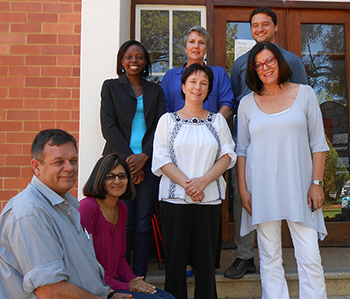Latest News Archive
Please select Category, Year, and then Month to display items
27 December 2021
|
Story Jóhann Thormählen
|
Photo Supplied
 The Kovsie Annerie Dercksen is one of South Africa’s most promising youngsters and climbing the cricketing ladder.
The Kovsie Annerie Dercksen is one of South Africa’s most promising youngsters and climbing the cricketing ladder.
She enjoyed every second of playing with some of her heroes and believes the exposure to international cricket will help her become a better player.
Annerie Dercksen is one of South Africa’s most promising youngsters and climbing the cricketing ladder.
Star from Beaufort West
This second-year Education student from the University of the Free State (UFS), who dreams of playing for the Momentum Proteas, represented the South African Emerging Women’s team three times in 2021.
The star from Beaufort West toured with the side to Bangladesh and also played against Zimbabwe and Thailand in One Day and T20 matches.
According to Dercksen, it is an incredible honour and privilege to be a part of a side.
She soaked up the experience and says everyone was willing to share their knowledge.
“I would have to say, sharing the field with some of my heroes and getting to work with some of the best coaches in the country are some of the highlights.”
She says each tour brought its own challenges and this helped her grow in the way she views and approaches the game.
“In Bangladesh we played against a well-established team in foreign conditions while facing a lot of spinners in spin friendly conditions. Personally, it was quite a challenge and I had to come back and work on some options, especially against spin.”
“Each tour brought its own challenges and this helped me grow in the way I view and approach the game.” - Annerie Dercksen
Coming through the ranks
The all-rounder has come through the ranks. She represented South-Western Districts at school level, played for the South African U19 side and is currently representing the Free State.
But Dercksen didn’t always dream cricket, especially not when playing ‘backyard’ cricket with her brother on the farm.
She didn’t even play for a team at school. “Until a boy from our primary school’s team got sick before a game. A teacher came to class and asked, ‘who can play cricket’, and I put up my hand.”
Fighting the tuberculosis battle as a collective
2015-09-28

The team hard at work making South Africa a
healthier place |
Tuberculosis (TB) is second only to HIV/AIDS as the greatest killer worldwide due to a single infectious agent. More than 95% of TB deaths occur in low- and middle-income countries. Despite being more prevalent among men than women, TB remains one of the top five causes of death amongst women between the ages of 15 and 44 years. While everyone is at risk for contracting TB, those most at risk include children under the age of five and the elderly. In addition, research indicates that individuals with compromised immune systems, household contacts with pulmonary TB patients, and healthcare workers are also at increased risk for contracting TB.
According to the Deputy Director of the Centre for Health Systems Research and Development (CHSR&D) at the UFS, Dr Michelle Engelbrecht, research has found that healthcare workers may be three times more likely to be infected by TB than the general population.
The unsettling fact
“Research done in health facilities in South Africa has found that nurses do not often participate in basic prevention acts, such as opening windows and wearing respirators when attending to infectious TB patients,” she explained.
In response to this concern, CHSR&D, which operates within the Faculty of Humanities at the the University of the Free State (UFS) Bloemfontein Campus has developed a research project to investigate TB prevention and infection control in primary healthcare facilities and households in Mangaung Metropolitan.
Action to counter the statistics
A team of four researchers and eight field workers from CHSR&D are in the process of gathering baseline data from the 41 primary healthcare facilities in Mangaung. The baseline comprises a facility assessment conducted with the TB nurse, and observations at each of the facilities. Individual interviews are also conducted with community caregivers, as well as TB and general patients. Self-administered questionnaires on knowledge, attitudes, and practices about TB infection control are completed by all nurses and facility-based community caregivers.
Healthcare workers are the main focus of this research, given their increased risk of acquiring TB in healthcare settings. At clinics, interventions will be developed to improve infection control practices by both healthcare workers and patients. TB patients’ households are also visited to screen household contacts for TB. Those found to have symptoms suggesting TB infection are referred to the clinics for further assessment and treatment.
The findings of this study will serve to inform the development of an intervention to address TB prevention and infection control in primary healthcare facilities. Further funding will be sought to implement and evaluate the intervention.
Curbing future infections and subsequent deaths as a result of TB is the priority for the UFS. The cooperation and collaboration of the community, government, and sponsors will ensure that this project is a success, hence prolonging life expectancy.